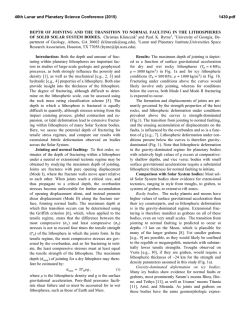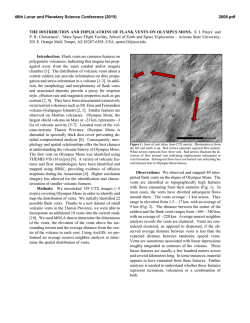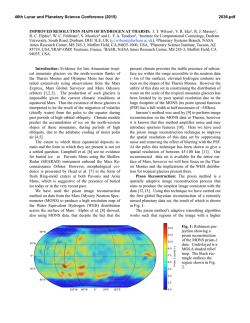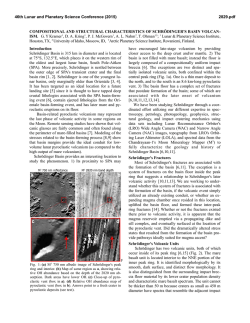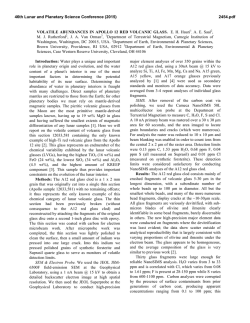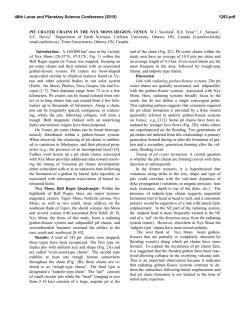
VOLCANIC SPREADING ON MARS: ROLE OF A - USRA
46th Lunar and Planetary Science Conference (2015) 2891.pdf VOLCANIC SPREADING ON MARS: ROLE OF A BASAL DECOLLEMENT ON FAULTING AND MAGMA PROPAGATION. N. Le Corvec and P. J. McGovern, Lunar and Planetary Institute, USRA, 3600 Bay Area Blvd, Houston, TX, 77058. Introduction: Mars possesses the largest volcanic edifices in our solar system (e.g., Olympus Mons, Ascraeus Mons). These volcanoes have low slopes (<10°), a caldera at their summit, and flank terraces considered as low angle thrust faults. These structural characteristics have been related to two main processes [1, 2]: lithospheric flexure, and gravitational spreading. The extent of flank terraces varies from one volcano to another [3]. Such variation might represent differences in the geometry of the edifice, the thickness of the lithosphere, and the coefficient of friction and thus the amount of spreading. The goal is to investigate the influence of lithospheric flexure and graviational spreading on the type and extent of faulting evident at the surface of the volcano, and on the type of magmatic intrusion inside the volcanic edifice. Model: Axisymmetric finite element models using COMSOL Multiphysics [4] of volcanic loading of an elastic cone on top of an elastic lithosphere were created. For each model, a range of elastic lithosphere thicknesses Te were studied (Table 1). Finite Element Models Models Radius (km) 1 100 Initial Height (km) 5 2 370 3 Slope (°) Te (km) 2.86 20 - 30 - 40 22 3.40 75 - 100 - 125 160 12 4.29 20 - 50 - 80 4 230 14 3.48 50 - 75 - 100 5 170 18 6.04 60 - 100 - 140 Table 1: Geometric setup of the different finite elements models. In each model, the radius of the lithosphere was set to 2000 km to avoid boundary effects in the flexural response. The volcano and the lithosphere have a density of 2800 kg/m3, and share the same elastic parameters: Poisson ratio = 0.25 and Young’s Modulus E = 1011 Pa. In order to study volcanic spreading, we introduced a frictional contact between the volcanic edifice and the lithosphere. The contact was characterized by various friction coefficients (μ), from frictionless (μ = 0) to natural friction coefficients of basaltic rocks (μ=0.6) [5]. The left boundary of the model represents the symmetric axis, the upper boundary of the model is set free, rollers are applied to the right boundary of the model restricting horizontal displacement, and the bottom boundary is defined by an equilibrium balancing the displacement of the lithosphere using “Winkler” restoring forces [6] and counteracts the loading of the pre-stressed layered lithosphere [7]. Preliminary Results: We tested 5 different models, described in Table 1. The type of faulting at the surface of the volcano is mainly dependent on the ability of the volcano to spread (Fig. 1). In model 1, we observe that volcanoes with a frictionless base display circumferential thrust faults over most of their flanks. The faulting at the base of the flank is dependent on the thickness of the lithosphere (which controls the amplitude and wavelength of flexural response). Thin lithosphere will create radial normal faults at the base, whereas thicker lithospheres produce strike-slip and circumferential normal faults. Volcanoes with finite friction bases show circumferential thrust extent limited to their summit, the flank is mostly cut by radial thrust faults (Fig. 1) with their base cut by strike-slip faults only for thin lithospheres. Comparing our results with the minima elevation found on several Martian volcanoes [3], we plotted the vertical extent of circumferential thrusts against the ratio between the volcano initial height and the lithosphere thickness (Fig. 2). We observe that the largest vertical extent of circumferential thrusts along a volcano’s flank occur for the models with a frictionless base. These elevation minima are comparable with the ones found on Martian volcanoes (Fig. 2, shaded area) [3]. We observe that the vertical extent is however not a systematic function of flexural response. Thinner lithospheres produce smaller elevation minima for model 5, while it is the inverse for model 2. On the other hand, models 1, 3 and 4 show elevation minima for their median lithospheric thickness. Future Work: These results will be used to model natural example on Mars. The locations of circumferential thrusts could yield information sufficient to constrain the elastic thickness under the volcanic edifice. References: [1] Byrne P.K., et al. (2013) Geology, 41, 339-342. [2] McGovern P.J., et al. (2014) Geological Society, London, Special Publications, 401. [3] Byrne P.K., et al. (2009) Earth and Planetary Science Letters, 281, 1-13. [4] COMSOL Version 4.3b, 2013. [5] Schultz R.A. (1995) Rock Mechanics and Rock Engineering, 28, 1-15. [6] Watts A.B. (2001) Isostasy and Flexure of the Lithosphere, 458. [7] Galgana G.A., et al. (2011) J. Geophys. Res., 116, E03009. 46th Lunar and Planetary Science Conference (2015) 2891.pdf Figure 1: Plots of the differential stress and the type of faulting on the volcano’s flank as a function of distance from the volcano’s summit for model 1. Each curve represents a different coefficient of friction at the base of the volcano. The colors represent the type of faulting: cyan corresponds to circumferential thrust (CT); orange to radial thrust (RT), yellow to strike slip (SS), purple to radial normal (RN), and green to circumferential normal (CN). Figure 2: Plot of the elevation minima of circumferential thrust as a function of the ratio between the initial volcano height and the lithospheric thickness. The shaded area represents the range of elevation minima for Martian volcanoes (e.g., Arsia Mons, Ascraeus Mons, Olympus Mons) [3]. Inset: The surface of the lithosphere before flexure represents the basal reference surface (0%), the elevation of the volcano after deformation corresponds to 100%. Reworked from [3].
© Copyright 2026
